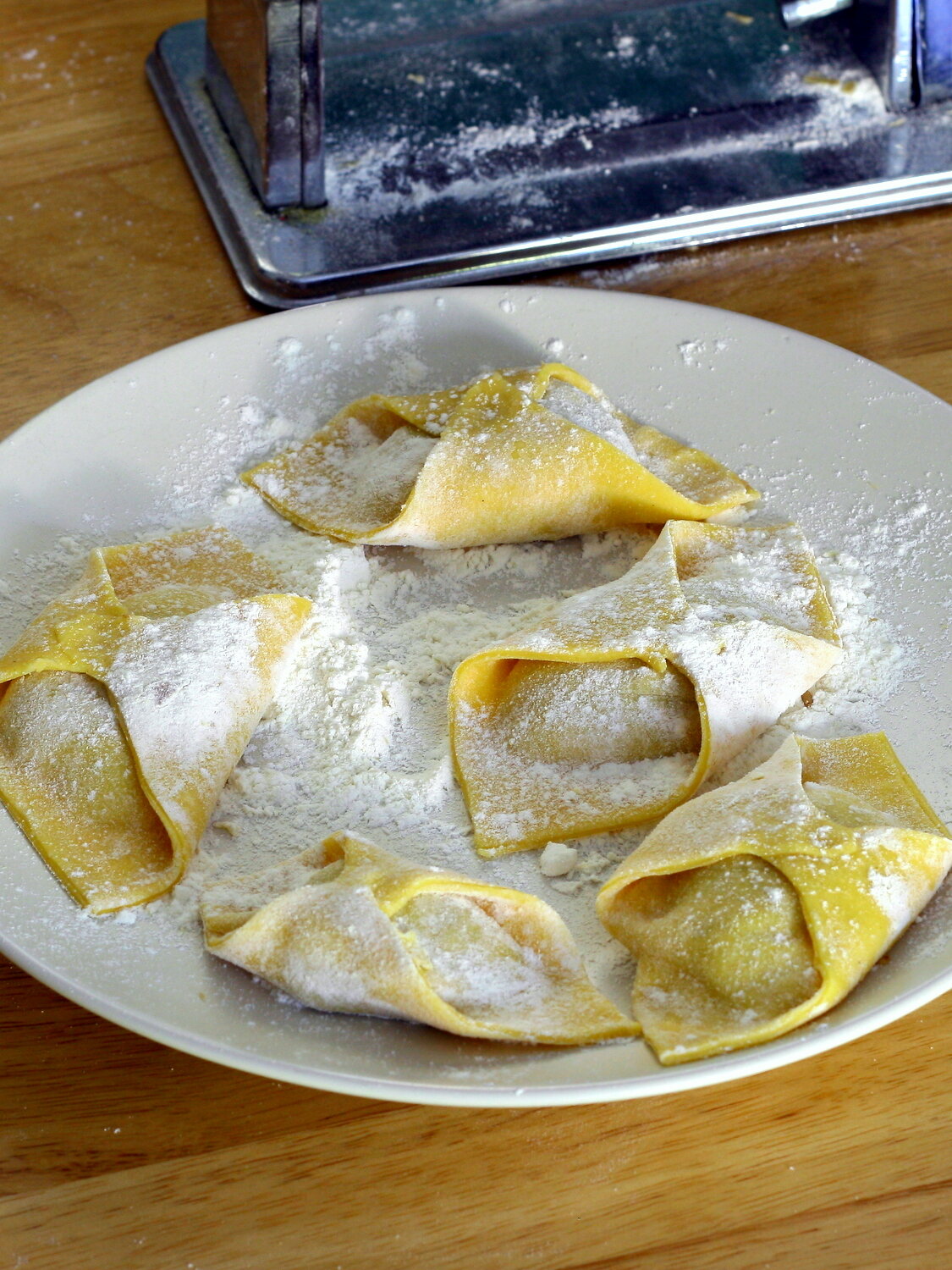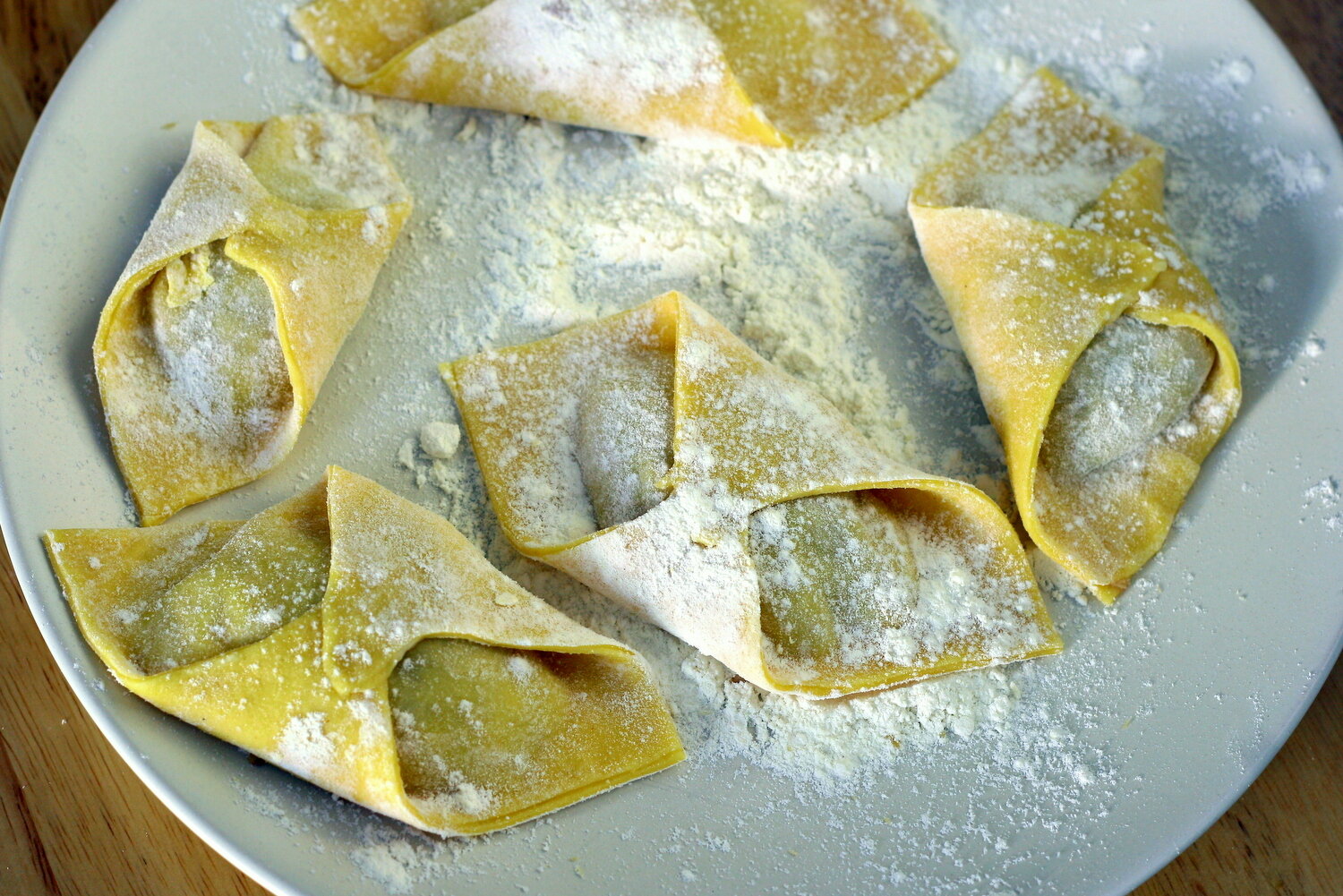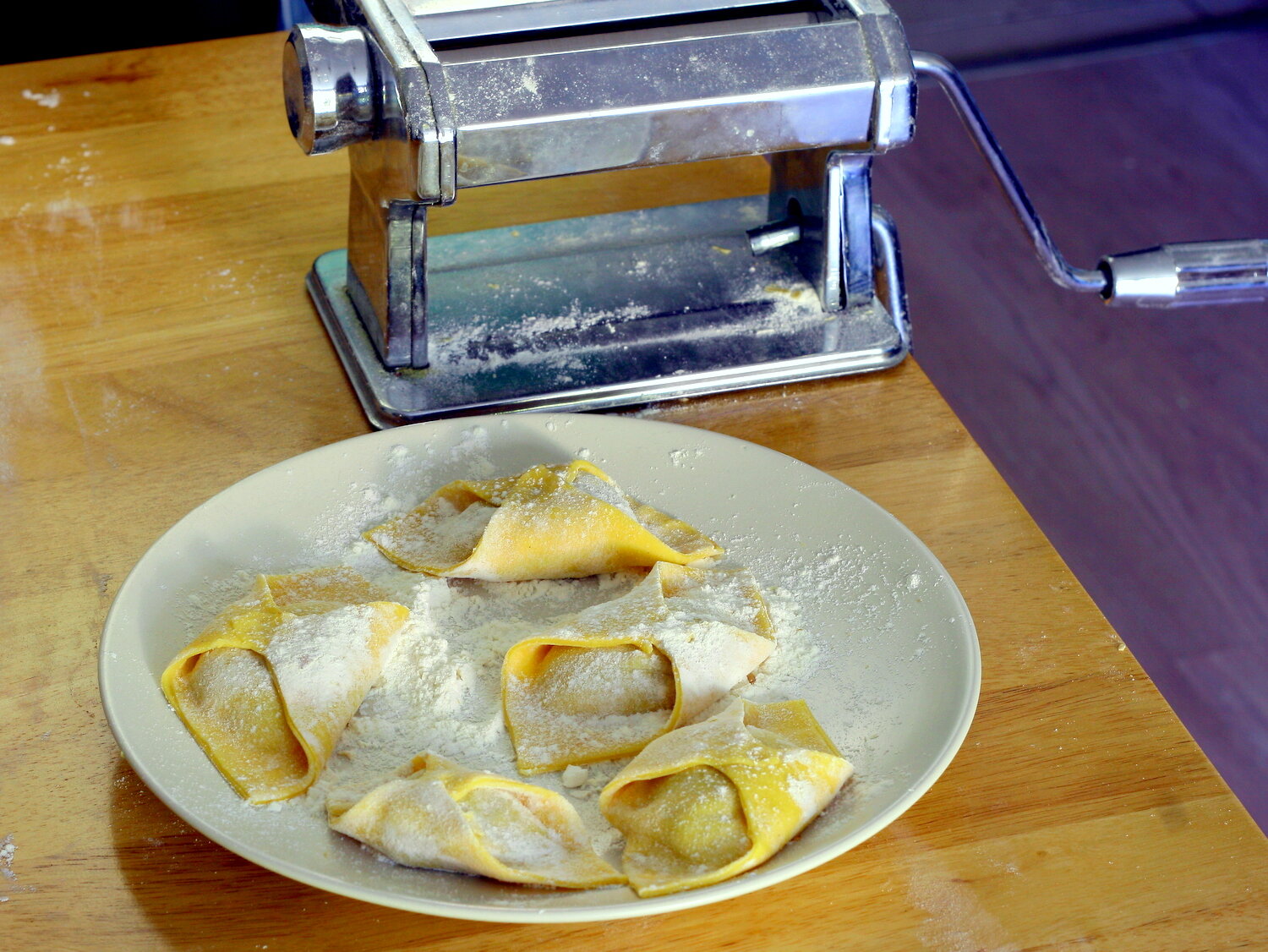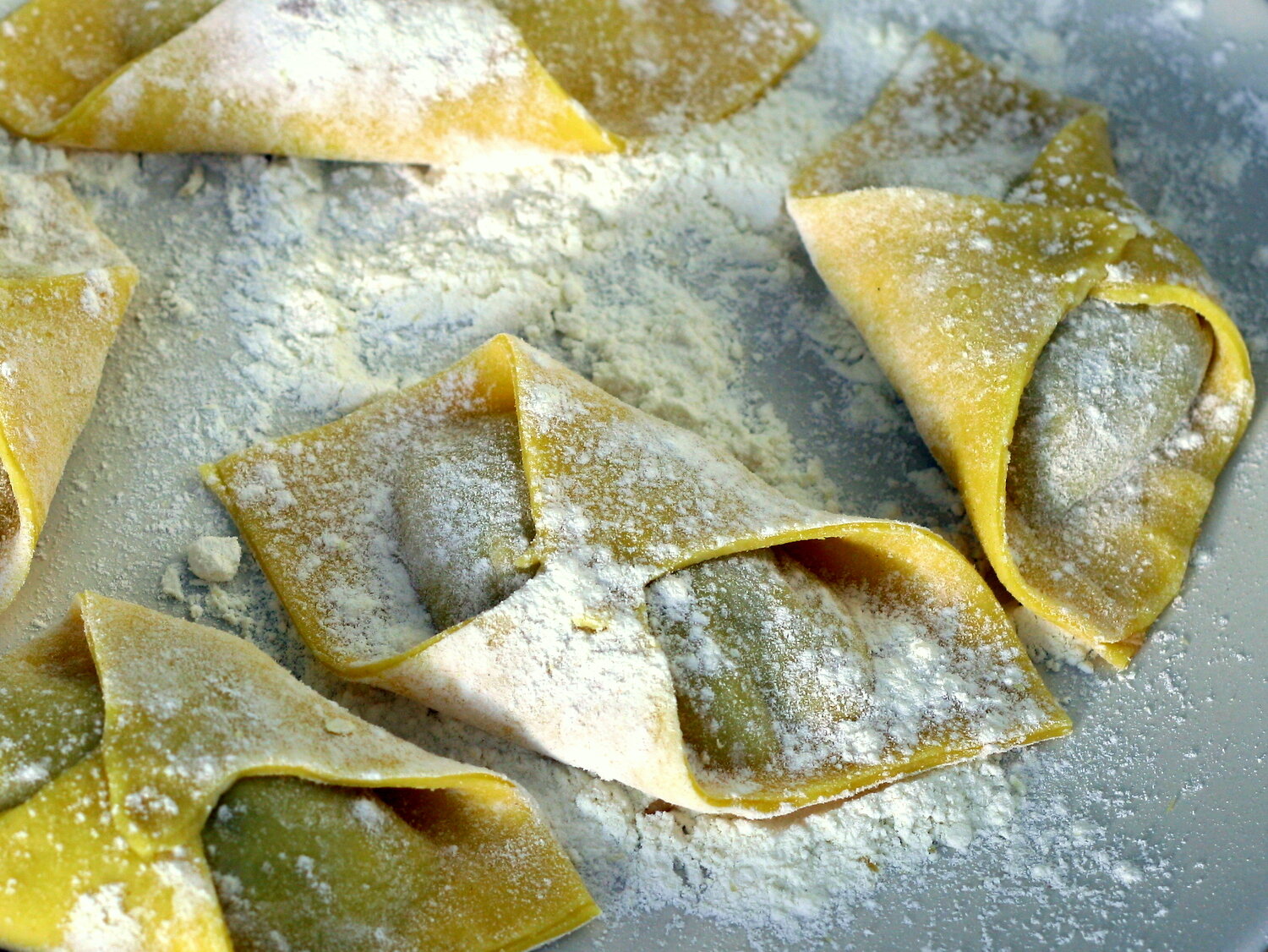Milk-braised pork tortelloni with a lemon zest finish
Elizabeth David is probably best known for bringing French cuisine to British tables. But her 1954 book Italian Food made a reasonable stab at introducing rural Italy's fresh, simple flavours to a United Kingdom only just relaxing from the grip of rationing.One of the fun things in Italian Food is a scrappy, half-explained braise of pork in milk with marjoram. Plated up as a main it would have all the appeal of stringy cement. But conceptually it's a nice way to keep slow-cooked pork moist and flavoursome.So how about wrapping it up in pasta, a rich carby cloak to hide its shame? Tortelloni are great (even if I did fold mine wrong), and keeping them large cuts down the hassle. What's fun here though is the addition of a little lemon zest, just before cooking. It steams in the filling so that when you slice into the pasta, you get this flash of zingy aroma, but the flavour doesn't overpower.
Tortelloni are great (even if I did fold mine wrong), and keeping them large cuts down the hassle. What's fun here though is the addition of a little lemon zest, just before cooking. It steams in the filling so that when you slice into the pasta, you get this flash of zingy aroma, but the flavour doesn't overpower.
Ingredients:
Filling:
- Pork shoulder, 600g
- Milk, 600ml (ish)
- Fresh sage, 6-8 leaves
- Lemon, 1 (well, a half)
- Bay leaves, 2
- Green peppercorns (brined), 1/4tsp
- Breadcrumbs, 60g (soft, fairly fresh)
Pasta:
- Pasta flour (The “00” kind), 250g
- 3 large eggs
This should give you enough for about 16 tortelloni. For rough guidance, the ones pictured are about 12cm long, and 4 is a healthy portion.
Sauce:
You can make all kinds of sauces for this, but I like a drizzle of beurre blanc, which is:
- Butter, 200g
- Dry white wine, 150ml
- Lemon juice, about 1tbsp (or the juice of the half you cook with)
- Shallot, 1 (or half a small onion)
- A few more green peppercorns
Serves 4 as a light main.
Instructions:
Filling
 Heat the oven to 180c. Roughly chop the pork into chunks, and put it in a pan with the milk, sage, bay, and peppercorns. Bring it gently to the boil, then put it in the oven, uncovered, for an hour and a half. It will form a kind of disquieting grey crust, and gradually cook down.After the oven time, the milk will have reduced to not much liquid, and some unappealing curdled goop. Don't think about it, just put it on the hob to reduce away the rest of the liquid. Cook it reasonably hot, stirring regularly, so that the moisture goes, and the pork breaks up. Eventually you'll have a kind of coherent mushy arrangement, almost like a coarse paté.Stir in the breadcrumbs, ensuring they're well mixed. It'll all cohere more, becoming dough-like, almost like a meatball mix. Which it kind of is. Leave this to cool.Just before you assemble the tortelloni, zest half a lemon, and stir the zest into the filling.
Heat the oven to 180c. Roughly chop the pork into chunks, and put it in a pan with the milk, sage, bay, and peppercorns. Bring it gently to the boil, then put it in the oven, uncovered, for an hour and a half. It will form a kind of disquieting grey crust, and gradually cook down.After the oven time, the milk will have reduced to not much liquid, and some unappealing curdled goop. Don't think about it, just put it on the hob to reduce away the rest of the liquid. Cook it reasonably hot, stirring regularly, so that the moisture goes, and the pork breaks up. Eventually you'll have a kind of coherent mushy arrangement, almost like a coarse paté.Stir in the breadcrumbs, ensuring they're well mixed. It'll all cohere more, becoming dough-like, almost like a meatball mix. Which it kind of is. Leave this to cool.Just before you assemble the tortelloni, zest half a lemon, and stir the zest into the filling.
Pasta
Separate one of the eggs, keeping yolk and white. Whisk the reserved white with a splash of water (or milk); we'll use it fro brushing the pastry later. Combine the yolk and the other two eggs with the flour, and work it all into a dough. If it seems very dry, add a teaspoon or so of water. Hopefully you won't need to.On a well-floured surface, knead the dough. Stop when the texture changes - it'll go supple and silky. You'll know when, but about ten minutes isn't uncommon.At this point, wrap it in cling film, and let it rest in the fridge for a few minutes. Maybe half an hour.Divide the dough into six or eight, depending on how many (and how large) tortelloni you want to make. Eight dough balls gets you 4x4 large-ish tortelloni. But for full disclosure: I had to roll 7 and make up an extra from the trimmings. While you work each ball, keep the others wrapped in cling film or under a cloth, to stop them drying out. Stretch each out into rough ovals with a rolling pin, and then feed it through a pasta machine on successively reducing thickness settings until you’ve got it at something like a millimeter and a half.Take the strips of rolled pasta, and lay out a pair on a well-floured surface. Dot one of them with four meatball-sized dollops of filling. Or however many fit. Mine were about 30g each, if that helps, but you can do a lot of smaller ones. Brush the other pasta sheet lightly with the egg white mix, and lay it carefully on top, pushing out any air pockets, and flattening down the little lumps of filling. Slice the pasta into four large square ravioli, and trim the edges to make them neat. Make sure the edges are well pressed down to seal.You could also trim them with one of those fluted-edging roller thingies, or cut them out in rounds. I like squares. Squares are easy. To shape mine a little, I pinched together two of the corners. These aren't proper tortelloni, but they look cool. To do it "properly", cut the pasta into squares first, dollop on the filling, brush the edges, and fold each square into a triangle, and pinch together the corners of the long side.Anyway, pick a shape you're happy with, dust the fuckers with flour, and put them to one side while you do the rest. Then have a glass of wine. You've been making pasta for nearly two hours; you've earned it.To cook the tortelloni, bring a lot of very salty water to the boil, and simmer (don't crowd them if you can avoid it) for about six minutes, or until the pasta is cooked but still has some bite. Dress with a simple sauce, and serve.
While you work each ball, keep the others wrapped in cling film or under a cloth, to stop them drying out. Stretch each out into rough ovals with a rolling pin, and then feed it through a pasta machine on successively reducing thickness settings until you’ve got it at something like a millimeter and a half.Take the strips of rolled pasta, and lay out a pair on a well-floured surface. Dot one of them with four meatball-sized dollops of filling. Or however many fit. Mine were about 30g each, if that helps, but you can do a lot of smaller ones. Brush the other pasta sheet lightly with the egg white mix, and lay it carefully on top, pushing out any air pockets, and flattening down the little lumps of filling. Slice the pasta into four large square ravioli, and trim the edges to make them neat. Make sure the edges are well pressed down to seal.You could also trim them with one of those fluted-edging roller thingies, or cut them out in rounds. I like squares. Squares are easy. To shape mine a little, I pinched together two of the corners. These aren't proper tortelloni, but they look cool. To do it "properly", cut the pasta into squares first, dollop on the filling, brush the edges, and fold each square into a triangle, and pinch together the corners of the long side.Anyway, pick a shape you're happy with, dust the fuckers with flour, and put them to one side while you do the rest. Then have a glass of wine. You've been making pasta for nearly two hours; you've earned it.To cook the tortelloni, bring a lot of very salty water to the boil, and simmer (don't crowd them if you can avoid it) for about six minutes, or until the pasta is cooked but still has some bite. Dress with a simple sauce, and serve.
Sauce
Cut the butter into little cubes. Loosely crush the peppercorns. Finely dice the onion or shallot, and put it in a pan with the pepper and liquid. On a medium heat, reduce this to about 1/3 the volume. If you want a smooth sauce, strain it at this point.Take it off the heat, and slowly add the butter. Start a cube at a time, whisking it in thoroughly as it melts. The sauce will begin to emulsify, and you can get more bold with the butter. Work it all in. You'll have something that looks like glossy custard.Caution: it splits like a motherfucker. Too hot, too cold - it splits. Do it either off the heat or over a water bath, and do it only just before serving. Drizzle a little over the pasta to moisten slightly. The peppercorn and sage flavours are muted by the long cooking, and the first hit is the lemon scent when you cut into the pasta. It's this little citrus-sweet flourish that fades to leave something milder on the palate. Keeping the sauce simple means nothing gets in the way here, and you can enjoy some surprisingly subtle flavours.It is - I confess - a right pain in the arse to make though.
The peppercorn and sage flavours are muted by the long cooking, and the first hit is the lemon scent when you cut into the pasta. It's this little citrus-sweet flourish that fades to leave something milder on the palate. Keeping the sauce simple means nothing gets in the way here, and you can enjoy some surprisingly subtle flavours.It is - I confess - a right pain in the arse to make though.
